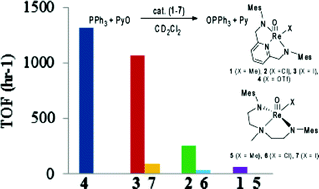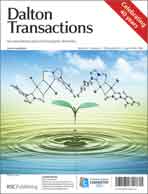The detailed syntheses of complexes 1–4, Re(O)(X)(DAP) (X = Me, 1; Cl, 2; I, 3; OTf (triflate), 4) incorporating the diamido pyridine (DAP) ancillary ligand (2,6-bis((mesitylamino)methyl)pyridine) are described and shown to be effective catalysts for oxygen atom transfer (OAT) reactions of PyO to PPh3. The catalytic activities are as follows: 4 ≈ 3 > 2 > 1. The observed electronic trend is consistent with the turnover limiting reduction of the proposed Re(VII) dioxo intermediate, Re(O)2(X)(DAP), during the catalytic cycle. The catalytic activity of complexes 1–3 was compared to previously published diamido amine (DAAm) oxorhenium complexes of the type Re(O)(X)(DAAm) (X = Me, 5; Cl, 6; I, 7 and DAAm = N,N-bis(2-arylaminoethyl)methylamine) which exhibit hydrolytic degradation during the catalytic reaction. Complexes 1–3 displayed higher turnover frequencies compared to 5–7. This higher catalytic activity was attributed to the more rigid DAP ligand backbone, which makes the complexes less susceptible to decomposition. However, another decomposition pathway was proposed for this catalytic system due to the observation of Re(O)3((MesNCH2)(MesNCH)NC5H3) 8 in which one arm of the DAP ligand is oxidized.

You have access to this article
 Please wait while we load your content...
Something went wrong. Try again?
Please wait while we load your content...
Something went wrong. Try again?


 Please wait while we load your content...
Please wait while we load your content...